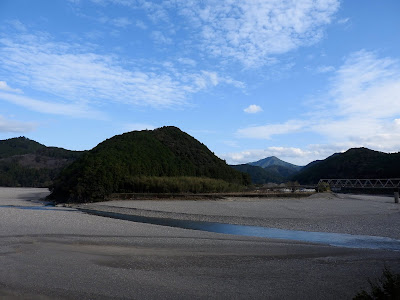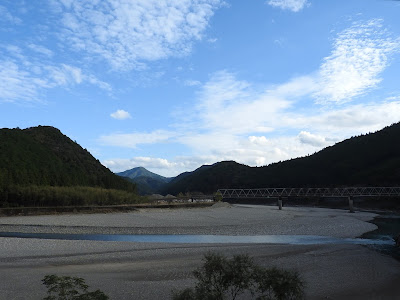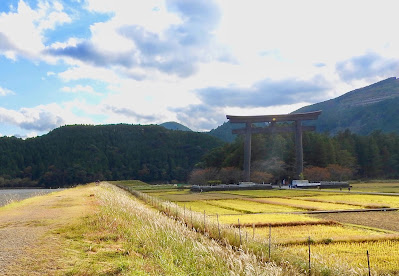 |
| 熊野・南紀旅行 11月12 - 14日 Kumano and Nanki Trip 12 -14th of November Kii Peninsula Trip |
目次 / Contents
1) おさらい / Review
2) 本宮大社のサイト / Hongū Taisha's Website
3) 大斎原 / Ōyunohara
A. 中洲 / River Island
B. 遷座 / Relocation
C. 現在 / Currently
1) おさらい / Review
 |
| 熊野川 (バスから撮影) 那智滝 (ナチノタキ)から始まった、 熊野本宮大社 (クマノホングウタイシャ)でした。 熊野本宮大社公式サイト : ★ Kumano River (Photograph from Coach) The last of our visits to Kumano Miyama, which started from Nachi Falls, Official Website : ★ Kumano River is a river in the Kii Peninsula, located in Nara, Wakayama and Mie Prefectures. and is 183 kilometres (114 mi) long. |
 |
| 熊野川 / Kumano River (バスから撮影 / Photograph from Coach) これまで何度も書いていますが、熊野三山は、 熊野本宮大社、 熊野那智大社 (クマノナチタイシャ) 熊野速玉大社 (クマノハヤタマタイシャ) の3つの神社の総称です。 (熊野三山は、日本全国に約3千社もしくは 4千社ある熊野神社の総本社です) 正確に言えば、その中には、那智滝、 及び那智大社の別宮の飛瀧神社と、 が含まれています。 |
なっています。
その雰囲気を経験するべく、熊野川水系北山川上流にある瀞峡 (ドロキョウ)で ウォータージェット船に乗りました。
瀞峡については下記。
本宮大社は山中にありますが、すぐ近くを流れる熊野川は広い河原を携えていることに驚きました。
 |
| 熊野川 / Kumano River (Photograph from Coach) As I have written many times, "Kumano Sanzan" : 'Three Grand Shrines of Kumano', below, Kumano Hongū Taisha, (The group, Kumano Sanzan, is the head office of more than 3,000 or 4,000 Kumano shrines spread all over Japan.) To be precise, it includes Nachi Falls and Hitaki Shrine, which is the annex of Nachi Taisha Shrine, and a temple adjacent to Nachi Taisha Shrine : |
Hongū Taisha Shrine and Hayatama Taisha Shrine are connected by the Kumano River, and have been the "River Pilgrimage Route" since ancient times.
To experience the atmosphere, we had boarded a Water Jet Boat Cruise : ★ in Dorokyo Gorge : ★, which is located upstream of the Kitayama River (Kumano River system) .
About Dorokyo Gorge, below.
Hongū Taisha Shrine is in the mountains, but I was surprised that the Kumano River, which runs nearby, has a wide riverbank.
 |
熊野古道 私が憧れた熊野古道 (クマノコドウ)は、 熊野三山へと通じる参道の総称です。 本宮大社中心に熊野古道が放射状に 伸びているのがわかります。 Map of Kumano Kodō : Map of the Old Roads of Kumano in Kii Peninsula, in Japanese Kumano Kodō, which I admired, are pilgrimage approaches to Kumano Sanzan. around Hongū Taisha Shrine. 画像は下記より / This from below ★ |
 この地域は、世界遺産 ・"紀伊山地の霊場と参詣道"と 吉野熊野国立公園 (ヨシノクマノコクリツコウエン) に指定されています。 |
| Red Circle ● : Sacred Sites and Pilgrimage Routes in the Kii Mountain Range 33°50′13″N 135°46′35″E This area is registered as part of the World Cultural Heritage Site of 画像は下記より / This from below★ |
那智滝については下記。/ About Nachi Falls, below.
熊野那智大社については下記。
About Kumano Nachi Taisha, below.
那智山青岸渡寺については下記。
About Nachisan Seiganto-ji Temple, below.
熊野速玉大社 については下記。
About Kumano Hayatama Taisha, below.
2) 本宮大社のサイト
Hongū Taisha's Website
2,000年以上もある熊野の歴史から自分の興味があることを取り上げまとめて各セクションに書いてきました。
ですが、熊野本宮大社公式サイトで、下のような、わかりやすい文章を見つけました。
"熊野本宮大社、熊野速玉大社、熊野那智大社を合わせて熊野三山といいます。
熊野の神々は自然信仰に根ざしていましたが、奈良~平安時代にかけて熊野は仏教・密教・修験道の聖地ともなり、神=仏であるという
熊野の神々は自然信仰に根ざしていましたが、奈良~平安時代にかけて熊野は仏教・密教・修験道の聖地ともなり、神=仏であるという
考え方が広まりました。
その影響を受けた三山は結びつきを深め、同じ12柱の神々(=仏たち)をおまつりするようになります。
その影響を受けた三山は結びつきを深め、同じ12柱の神々(=仏たち)をおまつりするようになります。
熊野三山の神秘性はますます高まり、平安時代の末には「浄土への入り口」として多くの皇族や貴族がお参りするようになりました。
浄土へお参りし、帰ってくるということは、死と再生を意味します。
そのため熊野三山は「よみがえりの聖地」として、今なお多くの人々の信仰を集めています。"
本地垂迹思想のこと、とてもわかりやすく説明されていて、"甦りの地"のことも、含められ、素晴らしいまとめ方に感じました。
まあ、違う捉え方をすれば、リサーチしたからこそ、この文章がうまくまとめられていることに感動できるのでしょう。(慰め...苦笑)
そしてありがたいことに、他の2社のサイトではなかった、英語表記もあり、私としても助かります。
英語表記にしても、こちらのサイトを最初に知っていれば、翻訳も楽であっただろうと思います....ウッウッ...
 |
| 熊野本宮大社門前 本宮大社は、和歌山県田辺市本宮町本宮1100にあります。 家都美御子大神 (ケツミミコノオオカミ / 他多数の別名)が 主祭神です。 この主祭神は、スサノオであり、平安(794 - 1185)以後は、 熊野権現と呼ばれます。 主祭神は一応あるものの、熊野三山ではどの神社も、 複数の神を祀っています。 In Front of Gate of Kumano Hongū Taisha Shrine The Shrine is located in 1100, Hongū, Hongū Town, Tanabe City, Wakayama Prefecture. Ketsumi Mikono Ogami (many other aliases) is the main deity. This main deity is Susanoo, and since the Heian period (794 - 1185), it has been called Kumano Gongen. Although there is a main deity, every shrine in Kumano Sanzan enshrines multiple deities. |
Hongū Taisha's Website
I have picked up what I am interested in from the history of Kumano, which has more than 2,000 years, and wrote about it in each section.
However, on the official website of Kumano Hongu Taisha Shrine,
I found easy-to-understand sentences in Japanese.
There is also some English that was not on the websites of the other two Shrines.
Even if it is written in English, if I had known this site first, I think my translations would have been easier .... Oh! Dear, dear...
See Hongū Taisha Shrine's website in English→★
 |
| 本宮周囲の案内板 Guide Map of Around Hongū Taisha Shrine Area Map in English here →★ |
2) 大斎原 / Ōyunohara
A. 中洲 / River Island
熊野本宮大社に到着し、まずは社殿を参拝しましたが、神社の歴史としては、もと、社殿があった場所、大斎原 (オオユノハラ) が先です。
このセクションでも、大斎原を先に取り上げたいと思います。
社伝では、
"大斎原と呼ばれる中洲に大斎原に、社殿が建てられたのは、
崇神天皇 (スジンテンノウ / BC148 - BC30 / 在位 : BC97 - BC30 )
65年(BC30年) としています。
その地に神が降臨したと伝えられています。"
時代がBCで、もうこれは神の時代であることを実感します。
那智大社は那智滝が神(熊野権現)とされ、速玉大社は、神(熊野権現)が諸国遍歴の末に神倉山に最初に降臨し、そこにはゴトビキ岩が神とされています。
ここ、本宮では、大斎原に神様が降臨されたとしています。
現在、それぞれに立派な社殿が建っていますが、私は那智滝、ゴトビキ岩、大斎原の地の方に魅力を感じてしまいます。
これは、本来私が自然信仰やアニミズムが好きなためなのかと思います。
下記、Wikiより
"熊野権現とは熊野三山の祭神である神々をいい、特に主祭神である家津美御子(けつみみこ)(スサノオ)・速玉(イザナギ)・牟須美(ふすび、むすび、または「結」とも表記)(イザナミ)のみを指して熊野三所権現、熊野三所権現以外の神々も含めて熊野十二所権現ともいう。"
 |
左:大鳥居 大鳥居の場所が熊野本宮大社旧社地です。 現在は川の形が変わり、明確に中州の形は わからないと言われますが、 なんとなく中洲であったことを感じます。 Left : Otorii ; Big Gate The location of the Otorii is the former Kumano Hongū Taisha Shrine. It is said that currently, the shape of the river has changed, and the shape of Nakasu : River Island is not clearly known, however, somehow I feel here was River Island. |
River Island
When we arrived at Kumano Hongū Taisha Shrine, we first visited the shrine, but in the shrine's history, Ōyunohara : 大斎原 is the place where the shrine was originally located.
In this section as well, I would like to show you Ōyunohara first.
Ōyunohara is located on a sandbank at the confluence of the Kumano, Otonashi, and Iwata rivers and is a Nakasu : River Island.
In the Shrine biography,
"The shrine was built in Ōyunohara in Nakasu, which is called Ōyunohara in BC30 ; 65 of Emperor Sujin (traditional, BC148 - BC30 / reign : BC97 - BC30).
It is said that God descended on that land. "
I realize that the era is BC and that this is the era of God.
At Nachi Taisha Shrine, Nachi Falls is the God (Kumano Gongen), and at Hayatama Taisha Shrine, the God (Kumano Gongen) first descends to Kamikurayama after a nationwide journey, and Gotobiki Rock is the God there.
Here in Hongū Taisha Shrine, it is said that the God descended on Ōyunohara.
Currently, each of them has a magnificent shrine, but I am attracted to Nachi Falls, Gotobiki Rock, and the land of Ōyunohara.
I think this is because I like natural beliefs and Animism.
According to Japanese Wiki about Kumano Gongen,
"Kumano Gongen refers to the Gods of Kuamano Sanzan, especially the three main deities Susanoo, Izanagi, and Izanami, called the Three Kumano Gongen : 熊野三所権現.
And also Three Kumano Gongen and 9 other Gods of Kumano are called 12 Kumano Gongen : 熊野十二所権現."
 |
| 左に熊野川、土手から撮影しています。 右に大鳥居 熊野川の土手に立って、地形(景色)を見ると、 人々がここに神が降臨したと信じることが 理解できる気がします。 気持ちが解放される空間が広がっています。 Kumano River on the left Photograph from Bank of Kumano River Otorii on the right I stood on the bank of the Kumano River and looked at the terrain (scenery), I feel I understand that people believe that God has descended here. Here is a space which make my feelings release and expand. |
大鳥居の場所に行く時間がありませんでした。
私が土手から景色を見てみたかったので、時間がなくなってしまったのかもしれません。
"2018年、創建2050年を迎えた熊野本宮大社の旧社地である大斎原は、「水霊の斎(いつ)く霊地」を意味し、古くは「聖水によって清められた地」として「大湯原」と表記されたことも。
また、熊野本宮大社では日照りが続いた際に雨乞いの儀式を行い、神々に祈りを捧げるということが執り行われてきた。
生命の起源である水の霊が宿る大斎原は、不老不死の楽土である“蓬莱山”にも例えられ、多くの魂が集う原郷でもある。"
作品の発想の殆どが水をイメージしている私にとって、'水の国' を
自称している和歌山には、もっと足を運ぶべきなのかもしれません。
(高野山は和歌山の地域名で山の名前ではありません)
梨木香歩 (1959 ~) さんの本:
『丹生都比売』(ニオツヒメ)[原生林,1995]
を読み、いつか行ってみたいと思っていた神社を '水の国・わかやまのサイト' : ★で紹介されていました。
『丹生都比売』については下記。
(丹生都比売神社の公式サイト:★)
もし次に和歌山へ行ける機会があるなら、大斎原も'丹生都比売大神'も訪ねたいです。
 |
| 日本一の大鳥居 (高さ34m、横42m) 大斎原は、現在の本宮大社から500mほど離れています。 本宮大社から道路を隔てて、大鳥居が見えます。 熊野本宮大社から徒歩10-15分。 Largest, Otorii in Japan (Height 34m, Width 42m) Ōyunohara is about 500m away from the current Hongū Taisha Shrine. You can see Otorii across the road from the Shrine. 10 - 15 minutes walk from the Shrine. |
We didn't have time to go there.
Maybe we've run out of time because I wanted to see the scenery from the bank.
According to 'Wakayama, a land of water' website : ★ (in English)
"The name of Oyunohara, the land where the Kumano Hongu Taisha Grand Shrine used to be located (2018 is the 2050th anniversary of its founding), means "sacred place where water deities are worshipped."
The "yu" part of the name was formerly written with a character meaning "hot water" rather than the current one that means "worship."
With that spelling, the name meant "place purified by sacred water."
Also, when Kumano Hongu Taisha was affected by an extended drought, a ceremony was held to pray to the gods for rain.
Oyunohara, where the water spirits dwell (water being the origin of life), is also compared to Mount Penglai, a paradise of eternal youth."
My ideas for my works usually come from water, so I may have to go to Wakayama Prefecture, which calls itself "land of water" again.
I have to go to "Niutsuhime Shrine" in Mount Kōya, Wakayama....
(Mount Kōya is the name of the area of Wakayama, not the name of the mountain
I read a book by Kaho Nashiki (1959 ~), "Niutsuhime" (Genseirin / 1995) and wanted to go to this shrine someday and I found out about it on 'Wakayama, a land of water' website : ★.
About the book : "Niutsuhime", below.
"Niutsuhime Shrine" is also registered as part of the World Cultural Heritage Site of the Sacred Sites and Pilgrimage Routes in the Kii Mountain Range
(Niutsuhime Official Website: ★ in English)
If I have another chance to go to Wakayama, I would like to visit both Ōyunohara
and "Niutsuhime Shrine"
熊野観光協会サイトでは、
"江戸時代まで中洲への橋がかけられる事はなく、参拝に訪れた人々は歩いて川を渡り、着物の裾を濡らしてから詣でるのがしきたりでした。
音無川の冷たい水で最後の水垢離を行って身を清め、神域に訪れたのです。"
と説明しています。
1889年(明治22年)、大洪水により、社殿は被害にあい、被害を免れた上四社三棟は1891年(明治24年)に現在の場所に移転されました。
2011年、紀伊半島大水害により、本宮大社は再び大斎原や瑞鳳殿 (スイホウデン) などに大きな被害を受けました。
2014年には瑞鳳殿が再建され、以前よりも立派になりました。
 |
| 熊野本宮并諸末社圖繒 (クマノホングウ ナラビ ショマツシャ ズエ) 江戸中期~後期頃の製作 当時、約1万1千坪の境内に五棟十二社の社殿、楼門、神楽殿や能舞台など、 現在の8倍の規模でした。 絵の全体の印象として、陰陽五行説 (オンヨウゴギョウセツ) の方位学を私は感じます。 おそらく、陰陽道だけでなく、他の諸宗教も影響を与えたであろうと推測します。 熊野は神仏習合ですからね。 Kumano Hongū and Shomatsusha Zue (Picture of Kumano Hongū Shrine and other small shrines) Drawn, from the middle to late Edo period. At that time, there were 5 buildings including (12 shrine halls), a tower gate, a Kagura Hall (Dance Hall), a Noh Stage and so on in the precincts of about 11,000 tsubo : 36363.69㎡, eight times as large as the current ones. As an overall impression, I feel the Direction of the Ying-Yang and Five Elements theory (Onyougogyosetsu) ; Onmyōdō. I presume that not only Onmyōdō but also other religions had an influence. Kumano is Shinbutsu-shūgō, isn't it? 画像は下記より / This from below ★ |
 |
陰陽五行 Ying-Yang and the Five Elements 画像は下記より/ This from below ★ |
Relocation
According to Kumano Tourism Association website in Japanese,
"Until the Edo period, there was no bridge to River island, and it was customary for visiting pilgrims who came to worship to walk across the river, and by tradition, wetting the hem of their kimono.
Lastly pilgrims purified themselves with the cold-water of the Otonashi River and reached the God Area. "
Lastly pilgrims purified themselves with the cold-water of the Otonashi River and reached the God Area. "
(Translation by me)
In 1889, the shrine was damaged by a great flood, and the buildings of the four halls that survived the damage were relocated to their current locations in 1891.
In 2011, due to a great flood on the Kii Peninsula, the Hongū Taisha Shrine was once again severely damaged.
In 2014, the Suihoden was rebuilt, and the Shrine is better than before.
 |
| Mandala of Kumano Hongū Taisha Shrine Worship 画像は下記より/ This from below ★  画像は下記より / This from below ★ |
C. 現在 / Currently
現在、大斎原には、1889年に流失した中四社・下四社 : 八柱と境内摂末社 (セツマツシャ) が祀られています。
八柱は下記。
1) 忍穂耳命 (アメノオシホミミノミコト) :
1) 忍穂耳命 (アメノオシホミミノミコト) :
2) 瓊々杵尊 (ニニギノミコト) :
忍穂耳命 と栲幡千千姫命 (タクハチヂヒメノミコト) の子。
3) 彦火火出見尊 (ヒコホホデミノミコト) : 山幸彦
4) 鵜葺草葺不合命 (ウガヤフキアエズノミコト) : 山幸彦の子。
5) 軻遇突智命 (カグツチノミコト) : 火の神。
カグツチは、殺されます。
6) 埴山姫命 (ハニヤマヒメノミコト) : ハニヤス。土の神。
イザナミの大便から誕生。
イザナミの尿 (ユマリ) から誕生。
8) 稚産霊命 (ワクムスビノカミ) : 食物 (ウケ) の神 。
イザナミの尿から、ミズハノメの後に誕生。
神様の誕生は、面白く、おおらか、そして激しい...ファンタジー色
いっぱいです。
イザナギとイザナミ、アマテラスとスサノオは、本宮大社に祀られています。
Currently
In Ōyunohara, the 8 halls were washed away in 1889 and currently, the eight Gods and other small shrines are still enshrined there.
The eight Gods are below.
1) Ame-no-oshihomim-Mikoto :
1) Ame-no-oshihomim-Mikoto :
2) Ninigi-no-Mikoto : A child of Ame-no-oshihomim-Mikoto and
Takuhata-chichihime-no-Mikoto ; Goddess.
3) Hikohohodemi no Mikoto : Yamasachi-hiko
4) Ugayafukiaezu-no-Mikoto : A child of Yamasachi-hiko
5) Kagutsuchi-no-Mikoto : The God of Fire.
By giving birth to this god, Izanami died and was killed by his
angry father, Izanagi, with the god sword: Totsuka-no-Tsurugi :
Ame-no-Ohabari'.
6) Hiniyamahime-no-Mikoto : Haniyasu. The God of Earth.
Born from Izanami's feces.
7) Mizuhanome-no-Kami : Mizuhanome. The God of Water.
Born from Izanami's urine (Yumari).
8) Wakumusubi-no-Kami : The God of Food (Uke).
Born after Mizuhanome from Izanami's urine (Yumari).
The births of the Gods are interesting, easygoing, and intense ... full of fantasy colours.
Izanagi and Izanami, Amaterasu and Susanoo are enshrined in Hongū Taisha Shrine.
熊野本宮大社参拝は次のセクションに載せます。
Visiting Kumano Hongū Taisha Shrine is in the next section.





0 件のコメント:
コメントを投稿